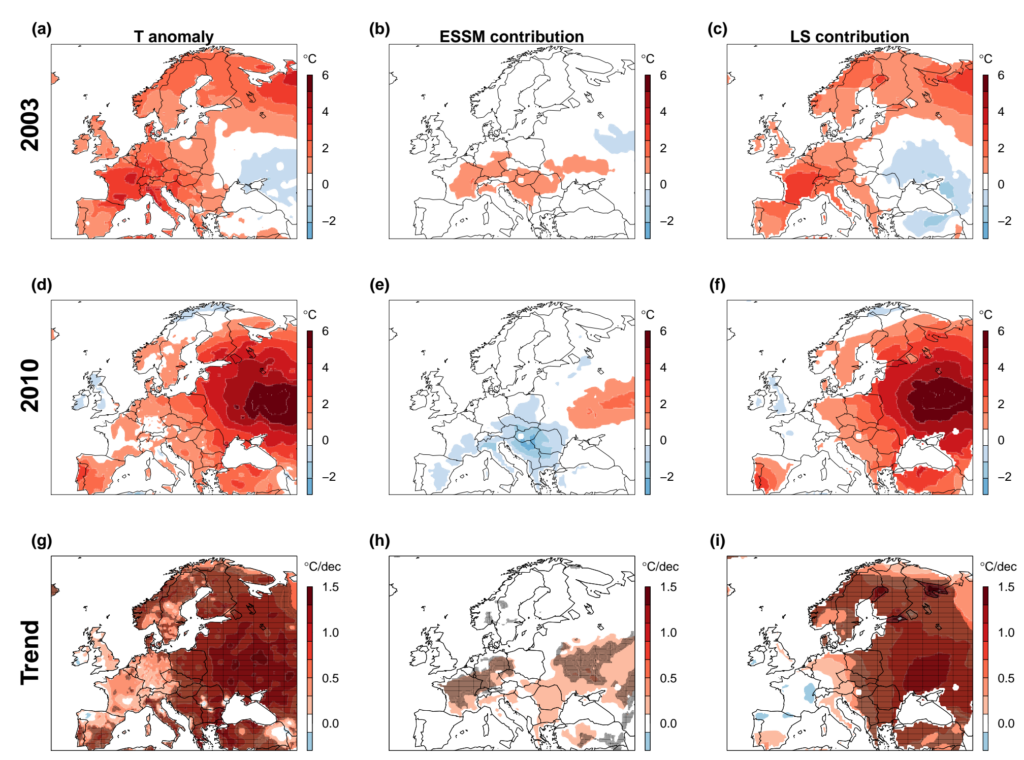European summers have become warmer in the last decades. To mitigate further warming, we have to better understand the cause of these increasing temperatures. In a recent study, Stegehuis et al. (2021) quantified the contribution of both decreasing soil moisture and atmospheric circulation to summer warming and summer heatwave events.
Soil moisture conditions play and important role in driving summer temperatures in Europe through land-atmosphere feedbacks. Over wet soils, incoming solar radiation will cause evaporation, and will be partitioned in both sensible and latent heat flux. Over dry soils however, there is less water to evaporate, and the incoming radiation will mostly be converted to sensible heat flux, increasing the air temperature. When soils dry out early in the season, a feedback mechanism may evolve, where drier soils cause higher air temperatures due to higher sensible heat flux, causing the soils to dry out even further. Besides soil moisture, large-scale atmospheric circulation also plays a role in the variability of summer temperatures. These large-scale drivers include for example atmospheric pressure patters, winds, and sea surface temperatures. To better understand warming and to be able to mitigate high summer temperatures, the contribution of these two drivers to high summer temperatures needs to be separated and quantified. This was done in a recent paper by Stegehuis and co-workers, by using twin-simulations of a regional climate model over the period from 1980-2011. They manually changed the soil moisture or the atmospheric circulation at the beginning of each summer, and ran the simulation till the end of the summer. The more than 900 simulated summers were subsequently analysed for the warming trend over the 32 year period and for two separate mega-heatwave events.

The results showed that deficits of early summer soil moisture explained the warming of ~0.1-0.2°C per decade in Western Europe, a large proportion of the overall warming trend. In Eastern Europe, the warming due to soil moisture was of similar magnitude, but most of the warming (approximately 1°C per decade), was linked to large-scale drivers. They also looked at individual heatwave events, and found that early summer soil moisture deficit explained 1-1.5°C of the 2003 temperature anomaly, similar to that of the mega heatwave in Russia in 2010. Large scale drivers however, explained 2-3°C in Western Europe, while this was 5-6°C in Russia.
These results suggest that adapting land management policies to retain more water in the spring can especially have a positive effect on the summer climate in central and Western Europe. In these regions, higher soil moisture levels may be able to reduce extreme warm summers in the future.
Further reading
Simpkins, G. (2021) Drought-related warming. Nat. Clim. Chang. 11,719, doi:10.1038/s41558-021-01147-x.
Stegehuis, A. I., M. M. Vogel, R. Vautard, P. Ciais, A. J. Teuling & S. I. Seneviratne (2021), Early summer soil moisture contribution to Western European summer warming. J. Geophys. Res. Atmos., 126, e2021JD034646, doi:10.1029/2021JD034646.

